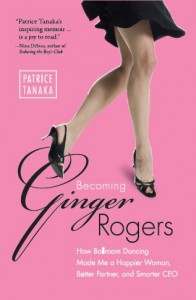
Business and Life Lessons From the Ballroom
Just in Time for “Dancing with the Stars” Finale
By Patrice Tanaka
Author, Becoming Ginger Rogers
and Co-Chair CRT/tanaka
Why is it that celebrities who’ve never danced ballroom before, from comedian Andy Dick to NFL wide receiver Jacoby Jones to country music singer Kellie Pickler, have been desperate not to be eliminated from season #16 of ABC’s “Dancing with the Stars” as this popular, prime-time TV show heads into the finale next week? Stars from this and previous seasons have rhapsodized about the life-transforming benefits of ballroom dancing, including weight loss, increased self-confidence, the thrill of performing full-out and fearlessly, a sense of pride in accomplishing something they’d never done before, and, importantly, the sheer joy they experienced through dance.
 Like celebrities from season #16 and each of the previous 15 seasons of “Dancing with the Stars,” ballroom dancing forever transformed my life. It’s made me a happier woman, a better partner, a smarter CEO, and now author of a book on the business and life lessons learned from ballroom dancing.
Like celebrities from season #16 and each of the previous 15 seasons of “Dancing with the Stars,” ballroom dancing forever transformed my life. It’s made me a happier woman, a better partner, a smarter CEO, and now author of a book on the business and life lessons learned from ballroom dancing.
Here are five lessons the ballroom world has to offer everyone – not just celebrities on “Dancing with the Stars” – from my book, Becoming Ginger Rogers:
1. To be fully present – mind, body, and spirit
To dance well, you must focus on executing your present step full out and fearlessly. It’s your best guarantee that you will produce a great next step or future. Beating yourself up over a misstep, i.e., being stuck in the past, has the domino effect of imperiling your present and future step.
Off the dance floor I learned how much more powerful I could be in business by being fully present and not trying to multitask when someone else was talking. We’ve all been guilty of this. In any meeting, half the group is usually answering e-mails on their smartphones. They’re half paying attention and consequently, only getting half the information (verbal and nonverbal) they need to make the best decisions and provide the most informed counsel to colleagues and clients.
Being fully present in a discussion, whether in your personal or professional life, results in better communication, better connections, and better partnering.
2. That Perfectionism is overrated – and inhibiting
At one ballroom dance competition, I made so many mistakes in my mambo (at the time my most terrifying dance) that I despaired of making the “finals,” which included the top six couples. I whined to my teacher that I knew I wouldn’t “place” (i.e., first, second or third in the finals) because of my mistakes. Well, lo and behold, I won first place. You’d think I would have been ecstatic. I wasn’t. I was bewildered that the judges awarded me a first place when I knew I didn’t deserve it. My teacher laughed when I told him I wanted to return my award. He explained that I won because I danced full out, communicated an understanding of the character of the dance, and showed that I was enjoying myself, not because I didn’t make any mistakes. That was a big revelation to me, and it has changed my approach in business.
Now, when I’m at work, I try to focus on executing a task full out and fearlessly rather than worrying about doing it perfectly, which would just make everyone around me afraid of making a mistake and, therefore, unwilling to risk trying innovative new ways to promote and market our clients. The process of producing breakthrough public relations and marketing is often messy because you’re not following a tried and true path; you’re pioneering a new one.
Requiring that the process of innovation be error-free crimps creativity and risk-taking. This, more than making mistakes, is what inhibits growth and innovation.
3. To practice failing so you can succeed more quickly
Professional dancers don’t view the process of working to improve their dancing as “succeeding” or “failing.” To them, it’s about continual improvement, practicing every day to be better dancers than they were the day before.
As our client, James Dyson, used to explain to the media when we launched his Dyson brand vacuum in the United States, it took him 15 years and 5,127 prototypes until he finally succeeded in inventing the DC01, the world’s first bag-less vacuum featuring cyclonic technology. Each of his 5,127 “failures” helped him, ultimately, to succeed.
From ballroom dancing, I’ve learned not to view so-called “failure” as failure either. I’ve come to view failure as a stepping stone to success. The more quickly you learn from your failures, the more quickly you can succeed.
4. How to partner for success
Close partnering is critical to winning ballroom competitions. A couple must be able to quickly and wordlessly execute midcourse corrections to avoid collisions when navigating a crowded dance floor filled with competitors.
As the woman in ballroom dancing, my job is to be alert and responsive in following the lead of my male partner. Although I’m not the leader in our dance partnership, I’m as responsible for our success as he is. As a female CEO used to leading in a business setting, it was difficult for me not to try to lead my partner on the dance floor. Allowing my partner to lead was critical, too, because ballroom judges will penalize a couple if there is a power struggle between leader and follower on the dance floor.
Since taking up ballroom dancing, I led my agency to win our biggest account by partnering with an outside marketing consultant. Moreover, I let him lead the account when we won it, which was something I had never done before with an outside consultant. One of my former partners astutely observed that had it not been for ballroom dancing, I could never have abdicated control in this way. He said the same thing when my partners and I decided to sell our New York City-based PR and marketing agency, PT&Co., to a Richmond, Va., firm, Carter Ryley Thomas. In so doing, I stepped down as CEO and agreed to follow the able leadership of Mark Raper as the leader of our very successful new agency, CRT/tanaka.
Ballroom dancing taught me that being a strong and active collaborator and follower is not necessarily a bad thing. It can be a winning strategy! Our new agency, CRT/tanaka, is three times the size of my previous agency, offering clients enhanced capabilities and additional geographies in which we can support them.
5. To visualize your goals as the first step toward achieving them
Many professional ballroom dancers visualize themselves competing or performing brilliantly before they take to the dance floor. They “see” themselves executing every step and every figure (set of steps). They feel what it’s like to excite the crowds, and they hear the roar of the crowd before the competition has even begun.
The ballroom world taught me that visualizing your dreams is the first step to realizing them. At CRT/tanaka, we’ve embraced “whatcanbe” as our brand vision, cultural ethos, and approach to business. Essentially, we believe that if you have a vision, it’s a simple matter of developing and implementing a plan of action to achieve that vision.
I’ve taken that approach to guide my personal and business life, as well, by visualizing and setting an intention for every outcome I want to achieve, including how I want to comport myself with everyone I interact with during the day. I set the intention just before walking into the office each day – that my every interaction with everyone be enhancing and affirming. I also visualize and set an intention for the outcome of every meeting that I participate in and for every initiative I undertake.
Patrice Tanaka is co-chair, chief creative officer and whatcanbe Ambassador for CRT/tanaka, an award-winning, national PR & marketing agency. Prior to co-founding CRT/tanaka in 2005, she led a management buyback from Chiat/Day to start PT&Co., leading it to become the “#1 Most Creative PR Agency in America.” Patrice is also the author of “Becoming Ginger Rogers…How Ballroom Dancing Made Me a Happier Woman, Better Partner and Smarter CEO.” Patrice can be reached at 646-216-6021 or PTanaka@CRT-tanaka.com.
Website: www.BecomingGingerRogers.com
Facebook: Becoming Ginger Rogers
Twitter: @BeGingerRogers

